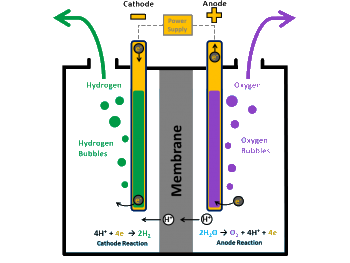ABB – ABB applies electrical expertise at major green hydrogen site in Denmark
- ABB will provide electrical engineering support for the H2 Energy Esbjerg hydrogen production facility in Denmark
- The 1 GW plant will produce 90,000 tons of green hydrogen per year, the equivalent of about 1.9 million barrels of oil per year
- Output to support decarbonization of heavy industry and road transportation
ABB has been contracted by Danish company H2 Energy Esbjerg ApS to provide basic electrical engineering for the power distribution from grid point of connection to electrolyzers, and for other process equipment at its 1 GW hydrogen production facility in Esbjerg and hydrogen distribution hub in Fredericia, Denmark. The plant, among the largest hydrogen developments in Europe, will produce up to 90,000 tons of hydrogen per year – the equivalent of about 1.9 million barrels of oil per year.
With this project, booked in Q3 2023, ABB will build on its expertise in the Power-to-X sector (PtX) for the development of green hydrogen, which already includes collaborations in Sweden, Norway, and elsewhere in Denmark.
The PtX facility in Esbjerg, scheduled to start operating by 2027, will convert renewable electricity from offshore wind into green hydrogen to support the decarbonization of heavy industry and road transportation. The hydrogen may also be used for the production of green e-fuels like methanol and ammonia.
“ABB is focused on supporting the EU’s priority to develop renewable hydrogen,” said Per-Erik Holsten, Head of Northern Europe at ABB Energy Industries. “We are increasingly active in the pioneering Power-to-X market which is essential in meeting global energy transition goals and achieving a low carbon society in the future.”
“It was important to collaborate with a company that has the knowledge of managing energy consumption and optimizing energy efficiency during green hydrogen production,” said Julian O’Connell, Project Director of H2 Energy Esbjerg ApS. “It is also critical to ensure we have a reliable and readily available supply of power to support operations at the distribution hub.”
The project by H2 Energy Esbjerg ApS is expected to create up to 60 permanent jobs and supply enough green hydrogen to meet the annual fuel consumption demands of more than 10,000 trucks, around half of all trucks in Denmark, and for heavy industry.
The International Energy Agency’s Global Hydrogen Review1 says the pipeline of projects for the production of low-emission hydrogen is growing at an impressive speed and it could reach up to 24 Mt per year by 2030, if all projects are realized.
1 https://www.iea.org/reports/global-hydrogen-review-2022
SourceABB
EMR Analysis
More information on ABB: See full profile on EMR Executive Services
More information on Björn Rosengren (Chief Executive Officer, ABB): See full profile on EMR Executive Services
More information on Per Erik Holsten (Head of Energy Industries, Northern Europe, ABB): See full profile on EMR Executive Services
More information on H2 Energy Esbjerg ApS: https://h2energy.ch/en/esbjerg/ + H2 Energy was founded in August 2014 with the goal of playing an active role stopping climate change. H2 Energy is involved in the entire hydrogen value chain, offering its know-how and engineering along each link. Especially in the realization of hydrogen production plants, the realization of hydrogen refueling stations and in the engineering of hydrogen fuel cell applications we draw on many years of experience.
More information on Lucas Grolimund (Chief Executive Officer, H2 Energy Holding Inc.): https://h2energy.ch/en/about-us/ + https://ch.linkedin.com/in/lucas-grolimund-646b67199
More information on Julian O’Connell (Project Director, H2 Energy Esbjerg ApS): https://ch.linkedin.com/in/julian-o-connell-26326977
More information on IEA (International Energy Agency): https://www.iea.org + The IEA is at the heart of global dialogue on energy, providing authoritative analysis, data, policy recommendations, and real-world solutions to help countries provide secure and sustainable energy for all.
The IEA was created in 1974 to help co-ordinate a collective response to major disruptions in the supply of oil. While oil security this remains a key aspect of our work, the IEA has evolved and expanded significantly since its foundation.
Taking an all-fuels, all-technology approach, the IEA recommends policies that enhance the reliability, affordability and sustainability of energy. It examines the full spectrum issues including renewables, oil, gas and coal supply and demand, energy efficiency, clean energy technologies, electricity systems and markets, access to energy, demand-side management, and much more.
Since 2015, the IEA has opened its doors to major emerging countries to expand its global impact, and deepen cooperation in energy security, data and statistics, energy policy analysis, energy efficiency, and the growing use of clean energy technologies.
More information on Net Zero: https://www.iea.org/reports/net-zero-by-2050 + The number of countries announcing pledges to achieve net zero emissions over the coming decades continues to grow. But the pledges by governments to date – even if fully achieved – fall well short of what is required to bring global energy-related carbon dioxide emissions to net zero by 2050 and give the world an even chance of limiting the global temperature rise to 1.5 °C. This special report is the world’s first comprehensive study of how to transition to a net zero energy system by 2050 while ensuring stable and affordable energy supplies, providing universal energy access, and enabling robust economic growth. It sets out a cost-effective and economically productive pathway, resulting in a clean, dynamic and resilient energy economy dominated by renewables like solar and wind instead of fossil fuels. The report also examines key uncertainties, such as the roles of bioenergy, carbon capture and behavioral changes in reaching net zero.
More information on Dr. Fatih Birol (Executive Director, International Energy Agency): https://www.iea.org/contributors/dr-fatih-birol + https://www.linkedin.com/in/fatih-birol/
EMR Additional Notes:
- What is Hydrogen? (Source: Hydrogeneurope.eu)
- The atom of hydrogen is the first element in the periodic table, with chemical symbol H and the first element created after the Big Bang. It is the most common substance in the universe and the richest energy source for stars like the sun. It consists of one proton (a core unit of positive charge) and one electron (negative charge).
- Hydrogen doesn’t exist naturally on Earth. Since it forms covalent compounds with most non-metallic elements, most of the hydrogen on Earth exists in molecular forms such as water or organic compounds. Combined with oxygen, it is water (H2O). Combined with carbon, it forms methane (CH4), coal, and petroleum. It is found in all growing things (biomass).
- Hydrogen (H2) is the most abundant element on earth but it rarely exists alone, therefore it is produced by extracting it from its compound.
- Hydrogen can be produced in numerous ways. Some methods produce CO2 while others are carbon free.
- H2 can be renewable or decarbonized if produced using renewable or carbon free electricity.
- Hydrogen has the highest energy content of any common fuel by weight.
- Hydrogen is a high efficiency, low polluting fuel that can be used for transportation, heating, and power generation in places where it is difficult to use electricity or as a CO2 neutral feedstock for chemical processes (ammonia-fertilizers).
- Grey, Blue or Green Hydrogen? (Source: International Energy Agency)
- There is a growing international consensus that clean hydrogen will play a key role in the world’s transition to a sustainable energy future. It is crucial to help reduce carbon emissions from industry and heavy transport, and also to provide long-term energy storage at scale.
- Researchers have found that clean hydrogen still costs too much to enable it to be widely deployed. Prices may not come down sufficiently until the 2030s, according to some estimates. But despite the uncertainty surrounding the future of clean hydrogen, there are promising signs that it could become more affordable sooner than expected.
- Where the hydrogen comes from is important. At the moment, it’s mainly produced industrially from natural gas, which generates significant carbon emissions. That type is known as “grey” hydrogen.
- A cleaner version is “blue” hydrogen, for which the carbon emissions are captured and stored, or reused.
- The cleanest one of all is “green” hydrogen, which is generated by renewable energy sources without producing carbon emissions in the first place.

- What is an hydrogen Electrolyzer?:
- An electrolyzer is a system that uses electricity to break water into hydrogen and oxygen in a process called electrolysis. Through electrolysis, the electrolyzer system creates hydrogen gas.
- Steam at the cathode combines with electrons from the external circuit to form hydrogen gas and negatively charged oxygen ions. The oxygen ions pass through the solid ceramic membrane and react at the anode to form oxygen gas and generate electrons for the external circuit.

- Kilowatt (kW):
- A kilowatt is simply a measure of how much power an electric appliance consumes—it’s 1,000 watts to be exact. You can quickly convert watts (W) to kilowatts (kW) by diving your wattage by 1,000: 1,000W 1,000 = 1 kW.
- Megawatt (MW):
- One megawatt equals one million watts or 1,000 kilowatts, roughly enough electricity for the instantaneous demand of 750 homes at once.
- Gigawatt (GW):
- A gigawatt (GW) is a unit of power, and it is equal to one billion watts.
- According to the Department of Energy, generating one GW of power takes over three million solar panels or 310 utility-scale wind turbines
- Carbon Dioxide (CO2):
- Primary greenhouse gas emitted through human activities. Carbon dioxide enters the atmosphere through burning fossil fuels (coal, natural gas, and oil), solid waste, trees and other biological materials, and also as a result of certain chemical reactions (e.g., manufacture of cement). Carbon dioxide is removed from the atmosphere (or “sequestered”) when it is absorbed by plants as part of the biological carbon cycle.
- Decarbonization:
- Reduction of carbon dioxide emissions through the use of low carbon power sources, achieving a lower output of greenhouse gasses into the atmosphere.
- Power-to-X (or P2X or PtX):
- Power-to-X is an energy transformation technology that converts electricity into carbon-neutral synthetic fuels (gas or liquid) which can be stored and later used by the mobility, heating and electricity sectors.
- Power-to-X is essential in achieving a carbon neutral society that meets an increasing demand for energy. Through electrolysis and CO2 reutilisation, Power-to-X can unlock carbon neutral solutions that mitigate unavoidable emissions from industry, for instance by capturing concentrated CO2 streams from biomass-fired power plants or anaerobic digestion. It also offers a competitive option for energy storage.
- The term Power-to-X covers processes for converting renewably sourced electricity (power) to a substance or energy carrier (“X”). This can be in gaseous form such as hydrogen or methane (synthetic natural gas, Power-to-Gas), or it can be liquid synthetic fuels such as methanol, ammonia, synthetic diesel, or kerosene (Power-to-Liquid). Liquid fuels from Power-to-X are also often referred to as electrofuels or merely e-fuels.
- e-Fuels – Electrofuels:
- eFuels are produced with electricity from renewable sources, water and CO2 and are a sustainable alternative to fossil fuels.
- Electrofuels, also known as e-fuels or synthetic fuels, are a type of drop-in replacement fuel. They are manufactured using captured carbon dioxide or carbon monoxide, together with hydrogen obtained from sustainable electricity sources such as wind, solar and nuclear power.


